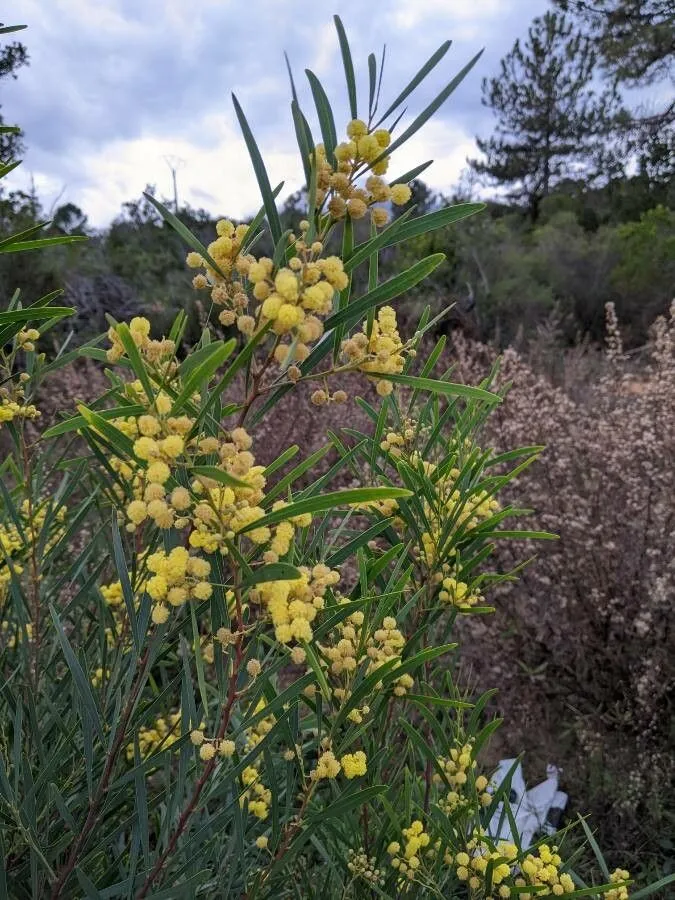
Author: Schltdl.
Bibliography: Linnaea 20: 664 (1847)
Year: 1847
Status: accepted
Rank: species
Genus: Acacia
Vegetable: Unknown
Observations: SE. South Australia
The Swamp Wattle, scientifically known as Acacia retinodes, is a distinguished member of the Fabaceae family. This plant was first described by the German botanist Diederich Franz Leonhard von Schlechtendal in the botanical journal Linnaea in 1847. Native to Southeast South Australia, the Swamp Wattle thrives in various environmental conditions, often found in moist, swampy areas, hence its common name.
This versatile flowering plant typically exhibits a robust and bushy growth habit, reaching impressive heights that contribute to its utility as a screening or ornamental foliage. The Swamp Wattle is characterized by its lush green, phyllode-like leaves which are actually modified leaf stems, offering a distinctive aesthetic appeal throughout the year.
One of the most striking features of Acacia retinodes is its beautiful display of bright yellow, globular flower heads. These blossoms are fragrant and occur sporadically throughout the year, although they peak in the spring and summer, attracting a variety of pollinators including bees and other beneficial insects. The flowers cluster together in large racemes, creating a visually stunning contrast with the green foliage.
In addition to its ornamental value, the Swamp Wattle plays a crucial role in its native habitat. It is well-adapted to cope with periodic flooding and poor soil conditions, which makes it an excellent plant for soil stabilization and rehabilitation projects. The plant’s root system is capable of fixing nitrogen, enriching the soil and benefiting surrounding plant life.
The Swamp Wattle’s adaptability and hardiness make it a popular choice for gardeners and landscapers seeking an enduring and attractive plant that provides both visual appeal and environmental benefits. With its origins deeply rooted in the diverse landscape of Southeast South Australia, Acacia retinodes continues to be a symbol of resilience and natural beauty.
Ita: acacia floribunda, gaggia, mimosa
Fra: mimosa d’été, mimosa des quatre saisons
Eng: silver wattle, swamp wattle, water wattle
Spa: acacia, mimosa
Por: acácia-virilda
Swe: hartsakacia
En: Swamp wattle, Silver wattle, Water wattle, Everblooming acacia, Wirilda
Ca: Mimosa de tot temps, Mimosa floribunda
Nl: Mimosa
Fr: Mimosa d’été, Mimosa des quatre saisons, Mimosa résineux
De: Immerblühende Akazie, Wasser Akazie, Mimose der vier Jahreszeiten
It: Acacia floribunda, Gaggia, Mimosa, Mimosa delle quattro stagioni
Fa: اقاقیا رتینودس
Pt: Acácia-virilda
Ru: Акация стойкая
Es: Acacia, Mimosa
Sv: Hartsakacia
Taken Sep 24, 2014 by Tela Botanica − Esra Gauthier (cc-by-sa)
Taken Feb 9, 2018 by Dieter Schulten (cc-by-sa)
Taken Nov 10, 1996 by Tela Botanica − Liliane Roubaudi (cc-by-sa)
Taken Apr 11, 2017 by Paolillo (cc-by-sa)
Taken Apr 20, 2018 by José Francisco Bruno García Rodríguez (cc-by-sa)
Taken Feb 15, 2022 by Monteiro Henrique (cc-by-sa)
Taken Mar 15, 2022 by Monteiro Henrique (cc-by-sa)
Taken Mar 29, 2022 by Monteiro Henrique (cc-by-sa)
Taken Mar 10, 2022 by Yves SPM (cc-by-sa)
Taken Jan 5, 2022 by Pasak Ewa (cc-by-sa)
Taken Oct 9, 2021 by Janine Zschech (cc-by-sa)
Taken Oct 19, 2020 by mario peters (cc-by-sa)
Taken Mar 12, 2021 by silvia mega (cc-by-sa)
Taken Mar 29, 2022 by Navarro David (cc-by-sa)
Taken Jan 6, 2021 by Garbovetzky Vera (cc-by-sa)
Taken Jan 6, 2021 by Garbovetzky Vera (cc-by-sa)
Taken Feb 3, 2022 by Monteiro Henrique (cc-by-sa)
Taken Feb 3, 2022 by Monteiro Henrique (cc-by-sa)
Taken Mar 8, 2022 by Monteiro Henrique (cc-by-sa)
Taken Mar 15, 2022 by serrano victoria (cc-by-sa)
Taken Oct 16, 2020 by Kenn Mackett (cc-by-sa)
Taken Aug 17, 2020 by Balas Fernando (cc-by-sa)
Taken Mar 8, 2022 by Monteiro Henrique (cc-by-sa)
Taken Feb 3, 2022 by Monteiro Henrique (cc-by-sa)
Taken Mar 10, 2022 by Yves SPM (cc-by-sa)
Taken Apr 15, 1999 by Photoflora – Jean-Luc TASSET (©)
Taken Feb 15, 1999 by Photoflora – Jean-Luc TASSET (©)
Taken Apr 15, 1987 by Photoflora – Jean-Luc TASSET (©)
Taken Nov 10, 1996 by Tela Botanica − Liliane Roubaudi (cc-by-sa)
Taken Jan 11, 2020 by Renaud Brochiero (cc-by-sa)
© copyright of the Board of Trustees of the Royal Botanic Gardens, Kew.
© copyright of the Board of Trustees of the Royal Botanic Gardens, Kew.
© copyright of the Board of Trustees of the Royal Botanic Gardens, Kew.
Family: Myrtaceae Author: (F.Muell.) K.D.Hill & L.A.S.Johnson Bibliography: Telopea 6: 402 (1995) Year: 1995 Status:…
Family: Rubiaceae Author: Pierre ex A.Froehner Bibliography: Notizbl. Bot. Gart. Berlin-Dahlem 1: 237 (1897) Year:…
Family: Sapindaceae Author: Koidz. Bibliography: J. Coll. Sci. Imp. Univ. Tokyo 32(1): 38 (1911) Year:…
Family: Asteraceae Author: A.Gray Bibliography: Pacif. Railr. Rep.: 107 (1857) Year: 1857 Status: accepted Rank:…
Family: Fabaceae Author: Medik. Bibliography: Vorles. Churpfälz. Phys.-Ökon. Ges. 2: 398 (1787) Year: 1787 Status:…
Family: Aspleniaceae Author: (Cav.) Alston Bibliography: Bull. Misc. Inform. Kew 1932: 309 (1932) Year: 1932…